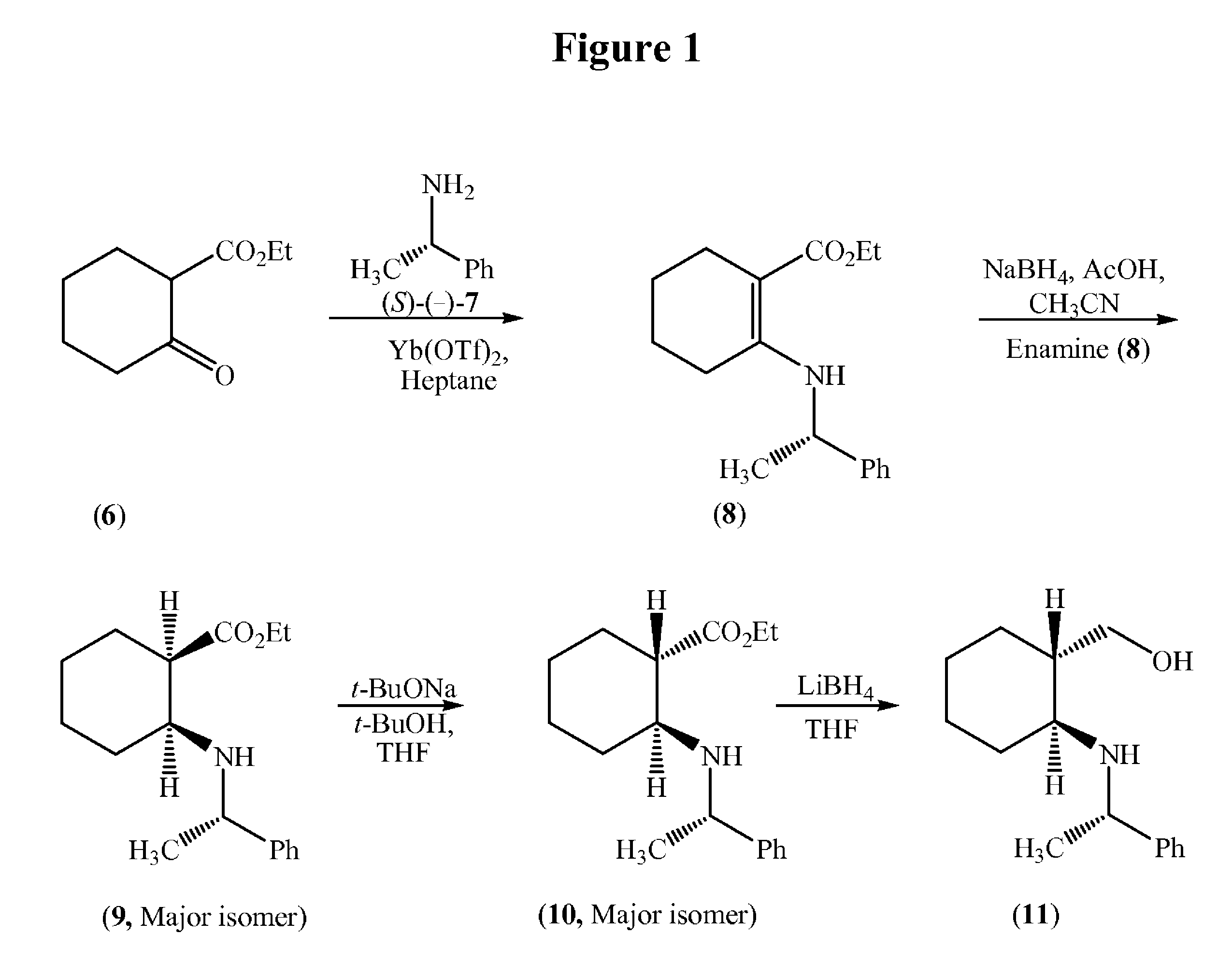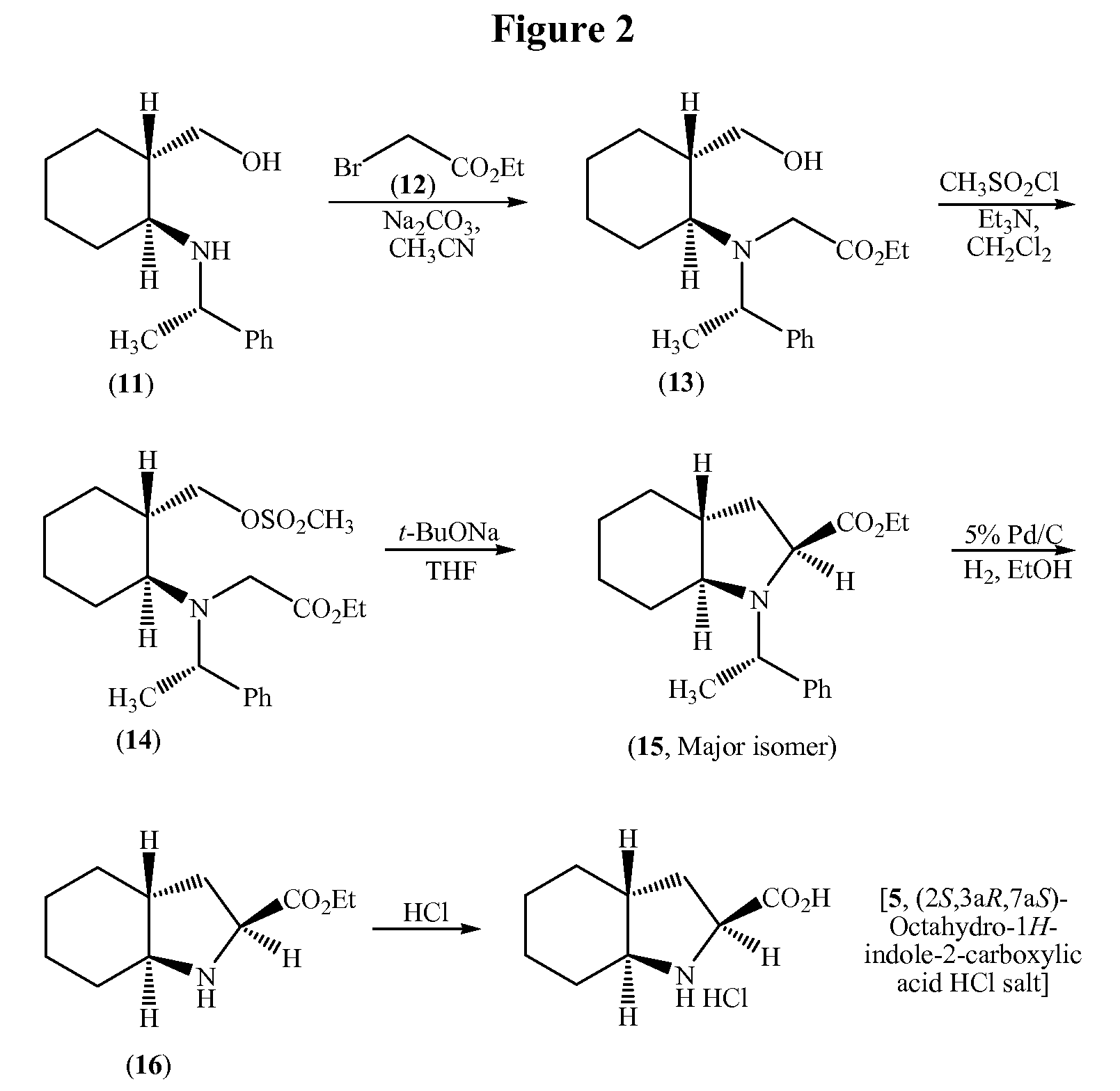Process for the synthesis of (2S,3AR,7AS)-octahydro-1H-indole carboxylic acid as an intermediate for trandolapril
a technology of indole carboxylic acid and synthesis process, which is applied in the field of synthesis of (2s,3ar,7as)-octahydro-1h-indole carboxylic acid as an intermediate for trandolapril, can solve the problems of low yield, inconvenient use, and inability to use in large-scale preparation, and achieve good overall yield
- Summary
- Abstract
- Description
- Claims
- Application Information
AI Technical Summary
Benefits of technology
Problems solved by technology
Method used
Image
Examples
example 1
(S)-Ethyl 2-(1-phenylethylamino)cyclohex-1-enecarboxylate (8)
[0059]
[0060]Ethyl 2-oxocyclohexane carboxylate (6, 484.9 g) and (S)-(−)-1-phenylethylamine (7, 362.5 g) were charged into an RB flask followed by heptanes (1.5 L) and Ytterbium (III) trifluoromethane sulfonate (8.8 g). The contents were heated to reflux for 3 hours and the liberated water was removed simultaneously and then cooled to 22° C. (±3° C.). The insoluble material was filtered and the filtrate was concentrate on a rotary evaporator under vacuum to afford 869.4 g of (S)-ethyl 2-(1-phenylethylamino)cyclohex-1-enecarboxylate (8) as an oil.
example 2
(1R,2S)-Ethyl 2-((S)-1-phenylethylamino)cyclohexanecarboxylate (9)
[0061]
[0062]Acetic acid (1.0 L) was added to a reactor followed by sodium borohydride (100 g) with cooling between 16-30° C. under nitrogen in NLT 1 hour and mixed for NLT 30 minutes. Acetonitrile (500 mL) was added and mixed for NLT 30 minutes, and the cooled to below 5° C. A solution of (S)-ethyl 2-(1-phenylethylamino)cyclohex-1-enecarboxylate (8, 269 g) dissolved in acetonitrile (250 mL) was added in NLT 30 minutes, while maintaining the temperature between 2-8° C. and then the reaction mixture was warmed to 22° C., and mixed for NLT 4 hours. The mixture was cooled below 5° C. and quenched with 1.77 L of 25% aqueous sodium hydroxide solution, water (1.3 L) and heptanes (0.75 L) and the pH was adjusted pH to ˜8.0. The organic layer was separated and the aqueous layer was extracted with heptanes (2×0.75 L), and then the combined heptane layers were washed with water (2×0.75 L) and 3.5 M aqueous sodium chloride soluti...
example 3
(1S,2S)-Ethyl 2-((S)-1-phenylethyl amino)cyclohexanecarboxylate (10)
[0063]
[0064]Tetrahydrofuran (1.25 L) was charged to a reactor followed by t-butanol (150 mL), and sodium t-butoxide (313 g) under nitrogen at ambient temperature. Additional tetrahydrofuran (1.0 L) was added and then the contents were cooled to <10° C. A solution of (1R,2S)-ethyl 2-((S)-1-phenylethylamino)cyclohexane carboxylate (9, 243.9 g) in tetrahydrofuran (300 mL) was added in NLT 30 minutes, while maintaining the temperature between 6-12° C. After the addition was complete, the mixture was warmed to 22° C. in NLT 30 minutes and further mixed for NLT 4 hours under nitrogen. The contents were cooled to <10° C. and the reaction was quenched with a solution of ammonium chloride (269.3 g) and water in NLT 30 minutes, while maintaining the temperature between 6-12° C. The lower aqueous layer was separated and extracted with 750 mL of heptanes. The upper organic layer was concentrated to about 0.8 L volume and extrac...
PUM
| Property | Measurement | Unit |
|---|---|---|
| temperature | aaaaa | aaaaa |
| temperature | aaaaa | aaaaa |
| temperature | aaaaa | aaaaa |
Abstract
Description
Claims
Application Information
 Login to View More
Login to View More - R&D
- Intellectual Property
- Life Sciences
- Materials
- Tech Scout
- Unparalleled Data Quality
- Higher Quality Content
- 60% Fewer Hallucinations
Browse by: Latest US Patents, China's latest patents, Technical Efficacy Thesaurus, Application Domain, Technology Topic, Popular Technical Reports.
© 2025 PatSnap. All rights reserved.Legal|Privacy policy|Modern Slavery Act Transparency Statement|Sitemap|About US| Contact US: help@patsnap.com



